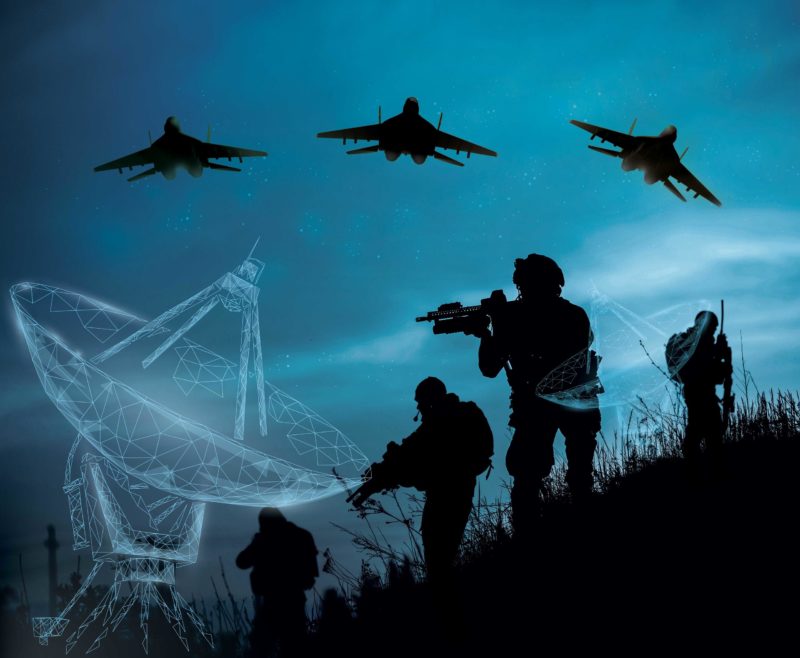Latest News
Satcom Tech Providers Must Have Virtualization Strategies to Meet Evolving Defense Needs

Photo: Via Satellite
The government and defense market has always relied on satellite communications, and this is only set to increase in the future. Mordor Intelligence projects a CAGR of 6.9% in the period between 2020 and 2025. Satellite communication is used across the breadth of the defense industry, around the world. From surveillance and tracking to remote sensing and disaster recovery, satellite is essential in enabling government and defense organizations to see the bigger picture and to access connectivity in the most remote and hostile regions of the world.
The commercial satellite sector is a critical source of bandwidth, products and services for defense users who are looking for high performance and efficiency. Access to ground infrastructure that enables support of multiple waveforms and software-defined networks that allow for better orchestration of services, dynamic provisioning, and scalability are essential to the support of this market.
The satellite industry itself is going through some disruptive changes. The blending of satellite and terrestrial networks and an increase in hybrid networking is very significant. Major developments in spacecraft design and the use of multiple orbits with large constellations of small satellites are shaking the industry up with the promise of faster, more cost-effective and low latency connectivity. This is coupled with emerging applications and technologies where satellite is poised to play a key part such as smart nation, smart defense, Internet of Things (IoT), and 5G that can enable better situational awareness, provide monitoring and speed up decision-making.
In order to access these technologies, there will be a move from hardware-based to software-based solutions through network virtualization, and cloud-based and edge computing. From the perspective of satellite, this will mean convergence of different networks through a centrally managed, agile and cloud-based, multi-orbit, multi-access technology platform. Due to the sensitive nature of the information exchanged, the cloud computing can remain within the realm of the private network with access to the public cloud for non-sensitive government and defense applications.
The Security and Cyber Question
Let’s now place all of this innovation against the backdrop of security and cyber challenges. The defense sector in particular is a prime target for both cybersecurity threats and intentional and unintentional signal interference. With the digitalization of the battlefield has come increased risk. Security systems must therefore have the capability to predict, detect, prevent, and mitigate the mix of threats that could hamper operations.
For interference detection, a network management system, spectrum monitoring, and geolocation services can identify potential threats. A spectrum monitoring solution can further detect any anomalies by pooling together bandwidth and comparing current conditions against a defined carrier plan. Geolocation can determine the latitude and longitude of an interfering signal and provide actionable intelligence by isolating and characterizing the source of interference.
When a security threat occurs, a proper mitigation response is needed. Signal excision technology and network diversity can help users swiftly leverage another network capacity to ensure persistent communications.
For prevention of future threats, transmission security (TRANSEC) and information assurance capabilities can ensure that systems remain resilient. TRANSEC technology keeps communications, and ultimately military operations, safe and secure as they transmit sensitive data over the airwaves.
Finally, prediction of future interferences and threats can be done by evaluating and understanding network activities, looking at historical data, and ensuring rapid response to adjust for any inconsistencies.
Increased Data Demand
In military operations, information superiority is key. Massive amounts of data are sent back and forth across military networks to provide instant situational awareness for intelligent decision making. Bandwidth-hungry applications such as Intelligence, Surveillance and Reconnaissance (ISR) video and sensors consume significant capacity on the satellite transponder. Strategic communications — as well as demands from emerging 5G, Machine-to-Machine (M2M) and Internet of Military Things (IoMT) sensors and devices— will further increase bandwidth consumption. Defense network operators will need to employ the latest Very Small Aperture Terminal (VSAT) and waveform technology advances to maximize throughput and efficiency.
They can do that by making sure that their satellite and ground segment technologies work hand in hand. While there is a lot of focus on the impact of new, Non-Geostationary (NGSO) satellite constellations, an innovative VSAT platform is also essential to ensure ongoing adaptability to changing environments and to achieve higher throughputs at maximum service availability.
Emerging Applications and Technologies
A virtualization strategy will become increasingly important for companies operating in the government and defense sector, enabling them to deploy technology more rapidly and cost effectively. By taking advantage of cloud computing capabilities, software-defined modems, and interfacing seamlessly with terrestrial networks for hybrid connectivity, they will be much more scalable and robust. Innovating in edge computing technology will also be necessary as more computing and data processing will be happening at the network edge, where devices and users are located. The main advantages are low latency data processing and communications to allow for split second decisions during an operation and the fact that sensitive tactical information can remain local without risk of interception.
As 5G strategies are gradually put in place by governments and militaries across the globe, the satellite industry is making big strides forward in terms of its work on integration into the 5G ecosystem. Various standards organizations (3GPP, 5GPPP, ETSI) and industry initiatives (Metro Ethernet Forum, MEF), as well as 5G consortia and projects (ESOA, SaT5G, SATis5 and Edgesat) are working to enable full orchestration and interoperability that will fuel applications such as data analytics, and Artificial Intelligence (AI).
With so much evolution happening within and outside of the satcom industry, technology providers must ensure that they provide the high performance, highly secure defense networks that are so critical today, but to have one foot firmly in the future to ensure that we are agile and ready to evolve with our customers’ networks whenever they are ready.
 Tim Winter is the Vice President of Global Accounts and International Defense at ST Engineering iDirect, a global leader in IP-based satellite communications. Winter manages all strategic global account engagements and capture pursuits for International Defense opportunities. Winter has more than 20 years of experience in both operational and sales leadership positions. He joined the company in 2018 after leading the managed satellite networks division at L3.
Tim Winter is the Vice President of Global Accounts and International Defense at ST Engineering iDirect, a global leader in IP-based satellite communications. Winter manages all strategic global account engagements and capture pursuits for International Defense opportunities. Winter has more than 20 years of experience in both operational and sales leadership positions. He joined the company in 2018 after leading the managed satellite networks division at L3.
Get the latest Via Satellite news!
Subscribe Now